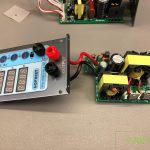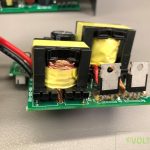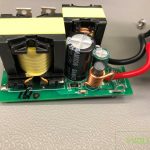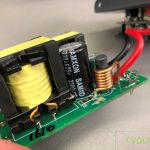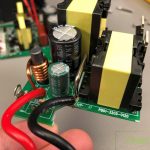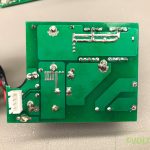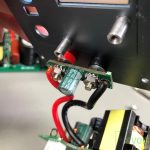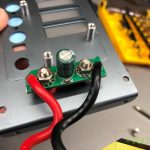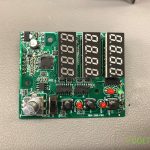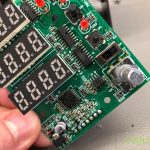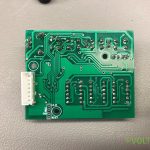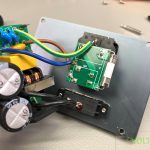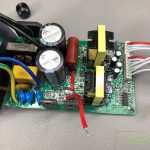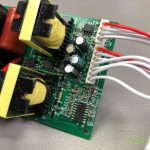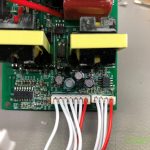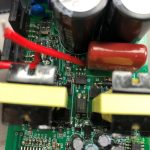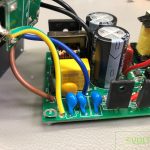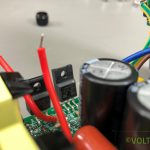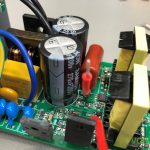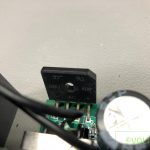Owon have had a bunch of power supply models in their lineup for a while but this new addition, the SPE series caught my eye because it’s in the affordable budget range and I really wanted to give this one a try to see if any good and if it will earn it’s spot on my workbench. So join me in this video to learn more about it.
Category: Review
This category will hold review articles.
Micsig DP10013 The Best Differential Probe To Get | Voltlog #392
Welcome to a new Voltlog, in this video we’re going to talk about oscilloscope differential probes and what I have here is the Micsig DP10013, this is a 100MHz differential probe that will probably help me not blow up my oscilloscope when probing high voltage stuff like inside a switch mode power supply.
But first a full disclosure, this unit was provided for free by bangggood.com for the purpose of this review and if you decide you decide to get one after watching the video check out the link I’ve placed in the description below, there will also be a discount coupon that you can use to get the Micsig for a better price.
So as usual with Micsig instruments they do come in these nice plastic carry cases, I mean they are not super high quality but certainly decent and certainly nice to have such a carry case for protection during shipping and for storage purposes.
Inside the carry case, we get the differential probe itself, a USB cable which is branded Ugreen, that’s actually nice to see, Ugreen makes good quality cables. If you’ve seen Micsig instruments before, you now they don’t use any batteries, they are powered over a USB port and that’s super useful and appreciated because this is the type of instrument that you will not be using everyday, this will mostly stay stored in it’s carry case for month before being used again and guess what happens when you forget about those batteries? Yeah they leak and they corrode the inside of your test gear so I very much like the fact that it doesn’t use batteries.
Gopher PPS-1610 PPS-3205 Review & Teardown | Voltlog #391
Welcome to another power supply review video, today it’s about the Gophert PPS-1610, I’m not sure how new this model is, I don’t know the exact date it came out but it’s fairly new and full disclosure this has been sent to me for free for the purpose of this review by a seller on aliexpress so should you decide to order one of these, there will be a link in the description below.
You may know I am a big fan of Gopher power supplies, I have like 5 units on my bench and they are generally my preferred way of powering stuff around the bench, unless I’m dealing with super sensitive analog stuff in which case I’m probably using my old trusty HP linear power supply. The gopher power supplies have been super reliable, for example I have been using my first one since 2015, that’s 6 years of usage already, I have subjected that power supply to multiple assembly/disassembly cycles for various teardowns and reverse engineering and to various noisy and spikey loads and full load conditions it just hasn’t failed me so far.
Teardown images below:
DytSpectrumOwl PCB Inspection Thermal Camera | Voltlog 384
Welcome to another Voltlog product review and in this video we are taking a look at the DytSpectrumOwl PCB thermal camera and let me tell you from the start that if you do a lot of PCB repairs or if you do any kind of product thermal characterization, your life would be so much better if you’ve had a tool like this and I’ll show you why in a few minutes.
The company that makes this product is DianYang Technology and I guess the name of the product is DyTSpectrumOwl model number CA-10, this is a 260×200 pixel resolution IR camera sensor with a 25 fps refresh rate and manual adjustable focus lens which allows it to focus from 20mm up to 2m, that 20mm close range focus and the 25hz refresh rate are very interesting features and I’ll talk more about that in a second.
I received the unit very well packed in a double cardboard box and all I have to do is to fix the vertical stand to the base and attach the camera. While doing this I couldn’t help to notice the very good construction quality, they’ve used anodized aluminium and metal parts everywhere, everything is nicely machined, rounded corners, really nice attention to detail, like for example , the work surface has an insulating rubber coating which would prevent shorting something on the PCB you are testing and on the bottom side they have nice rubber bumpers to prevent it from sliding around. Inside the box they include a small screwdriver that you use for attaching the vertical stand to the base, a couple of spare screws and a USB type-C to USB Type-A data cable.
Camera has a USB Type-C interface, looks like the shell is made from plastic and painted the same metal gray color and you get a single on/off button with a status LED on the top. On the sensor side you get this big focus adjustment wheel and we’ll play with that later on when we get to look at a PCB but since we are talking about PCBs let me introduce the sponsor of this video
Raised to its maximum setting, you get about 15cm of clearance between the work surface and the camera and that’s plenty if you ask me and you also get the option of moving the stand to the left of the work surface by using these mounting points. There are a few adjustments on the standm you can raise or lower the camera by sliding on the vertical rod but you can also do fine adjustment with this thumbwheel at the top. Then you can move back and forward from this adjustment and you can also adjust the angle of the camera so you can pretty much get this into every angle you want but I would probably use this looking straight down at a PCB.
Owon HDS242S Oscilloscope AWG Multimeter 3in1 Review & Teardown | Voltlog 380
Welcome to a new Voltlog, In this video we’re taking a look at the OWON HDS242S which is a dual channel 40MHz portable oscilloscope coupled with a 20000 count true RMS digital multimeter and an arbitrary waveform generator capable of 25Mhz sine and 5MHz square wave, all in this portable format with a 3.5inch color TFT display. As part of their line-up you can also get the HDS272S which bumps the oscilloscope up to 70Mhz. You can also get these without the function generator option and those would not have the ending S in their model number.
You Need This Instrument Right Now | Voltlog 376
Inside the box we are greeted with the instrument and I must say I expected a compact unit but this blows my minds, it’s actually smaller when you get to see it in real life and it feels kinda strange because it has all the visual cues of a professional instrument with the exception of size, it’s something new but I expect to see more of these miniaturized instruments in the next couple of years. You also get a power adapter and one that apparently has all of the safety certifications and it comes with these exchangeable socket adapters, you get the USB power lead which is just an adapter from USB to barrel jack and you also get two coaxial cables, that’s pretty much all you need to get started.
I have the ETG962E 60MHz model here but right from the start you shouldn’t set your expectations too high just because you see the 60MHz bandwidth mentioned because take a look at the sample rate, it’s 200MSamples/sec so at the max output of 60MHz you’re only getting roughly 3 samples per second which isn’t enough to describe a clear simple waveform, not to mention some more complicated waveforms. I mean it might do ok with a sine wave just because it can specify the top and bottom points and with a slower rise time it will automatically turn it into a sine wave but that’s pretty much all you’re going to get at the max output of 60MHz. So they’re kind of pushing the max spec of this unit for marketing purposes by specifying it at 60MHz when in fact it can do that for anything other than a sine wave.
It’s pretty obvious that you need to cut some corners to be able to offer such an instrument in the $150 range shipping included but as long as you are aware of these limitations, it’s still a pretty good offer, actually it’s the best offer on the market just because there isn’t anything like this available with similar specs in a similar price range and with the same quality.
Ynvisible Ultra Low-Power Display Technology – Voltlog #375
Welcome to a new Voltlog, today we are taking a look at some pretty interesting display technology, this evaluation kit was sent to me by the company named YNVISIBLE for the purpose of this review, they developed this display technology based on Electrochromism, this is defined as the property of a material to change color when voltage is applied. I’m sure this sounds familiar because similar properties of materials are used in e-paper or e-ink displays, they both reflect ambient light but in the case of e-ink the technology is different , as e-ink display are based on electrophoretic properties.
So this is what you get inside the kit, I like how it’s put together and you can get started evaluating the technology as soon as you open the box because, besides providing you with a wide selection of display examples based on their technology, you also get some ready to go boards to drive these display units.
Before telling you more about the display technology let me quickly connect one of these to the demo board to show you how it looks. I noticed two things immediately, it does take some time for the cells to change color but it’s really simple to drive these as you can connect them directly to MCU pins and just drive them directly. For example this 3 segment display, has a 4 pin connection, one common pin and one connection for each segment. Drive it high or low to go from color to bleach state. So you start to imagine how this can enable some very low cost devices to be built.
Aneng AN888S Multimeter With Bluetooth Speaker Review & Teardown – Voltlog #374
Welcome to a new Voltlog, today we are taking a look at this true RMS auto-ranging bench multimeter unit from Aneng but as we know we typically find the Aneng meters being sold under other names, different colors so for example this one is also available under the model name ZT-5566 and ZT-5566SE which I’m not really sure but might be able to provide spoken measurement via it’s built-in speaker while the one I have here only has bluetooth speaker functionality. Yup you’ve heard that right, it’s a multimeter combined with a bluetooth speaker. This unit was provided for free by banggood.com for the purpose of this review and if you would like to order one after watching this video, please consider using the link I’ve placed in the description of the video.
This is a 20000 count meter and the dc voltage accuracy is 0.05%+3 counts, dc current 0,5%+3 counts, an update rate of 3 measurements per second, it can also do ohms, capacitance, diode, continuity, frequency, duty cycle. There is no CAT safety rating printed on this meter, they probably don’t bother with that any more but we should be able to evaluate general safety measures later in our teardown. I don’t see myself playing music through this while working on my projects but I could definitely see myself playing one of my favorite podcasts while working on some electronics, like for example TheAmpHour show which I often listen to while assembling or debugging boards.
Uni-T UT501A Insulation Tester Review & Teardown – Voltlog #372
Welcome to a new Voltlog, for today I’m going to review & teardown this Uni-T Insulation Tester, the model number is UT501A. We’re going to start with a general introduction and then continue with a teardown and presenting some real world test scenarios. If at any point you are interested in ordering one, please check out the links I’ve placed in the description below.
So, like the name implies, this meter is good for testing insulation resistance but why would you need to do that? Well you would want to test the insulation resistance of a particular circuit or piece of machinery immediately after first installation or repair or through its service life to discover potential problems before they occur.
Let’s take for example the winding of a motor, every turn of copper wire is insulated but because of stress, harsh operating environment, over time, the insulation might start to fail and by testing regularly you can start to nice if the insulation resistance starts to drop and you might be able to service that piece of equipment before catastrophic failure.
Or another good example is when you wire up the electrical installation for a new home. During the installation procedure or during the construction period, accidental damage might occur to the wiring so it’s good practice to test for insulation resistance before you start using the new installation.
Pokit Meter Review – Voltlog #371
This is a bluetooth pocket multimeter which means it doesn’t have a display, it uses a smartphone/tablet app to display the measured data and it can do almost everything that a basic meter does: it can measure ac/dc voltage but no true RMS capability on this model, ac/dc current, resistance, continuity, diodes and as a bonus it can also do data logging and it has an oscilloscope mode but with a more limited range of values & functionality given its size. I find this pretty cool, because they managed to build so many functions inside such a small package like I have not seen pocket multimeters that can do data logging so far.
Right from the start you realize why they call it a pokit meter, it’s basically the size of a small puck, less than 5cm in diameter and about 17mm thick. Inside the box you get the meter itself, a pair of J-clips, a spare fuse, a small neoprene carry case and a quick starting guide. The first thing you need to do is to remove the battery seal and you have to twist the battery cap for release and then pull on the small insulating paper which then activates the CR2032 battery.
